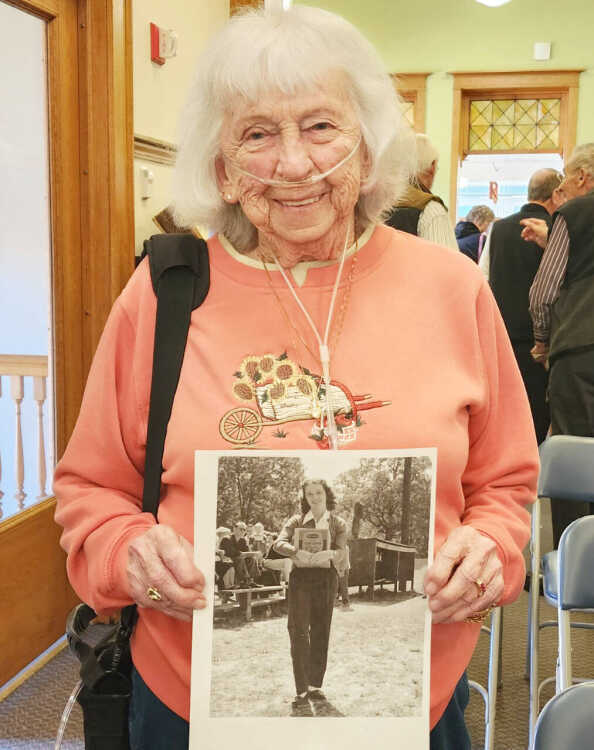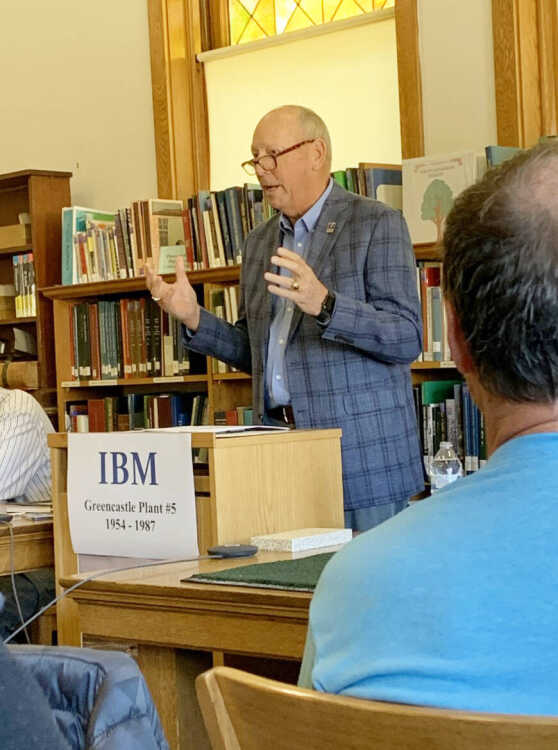Legacy of IBM examined in PCPL event

Taking a stroll down memory lane Saturday afternoon, retired Greencastle IBMers and area residents revisited the technology giant’s local legacy in a program at the Putnam County Public Library.
Speaking to some 60 attendees, including 20-25 IBM retirees, longtime employee Duane Kelly suggested, “Generally we would all agree we worked for IBM in its golden years. The IBM that’s out there now is not the IBM we know.”
Kelly joined former Mayor Mike Harmless, realtor Bob Evans of Collins-Evans Real Estate and Bill Marley, retired former president of First United Savings Bank, in reliving the IBM years from “breaking ground in 1954” to “abruptly leaving in 1987,” library archivist Tony Barger said in introducing the panel.
The program, Barger noted, is part of a celebration of Putnam County’s 200th anniversary.
“I don’t think you can write the history of Putnam County without talking about IBM,” Barger added. “Every time I meet an IBMer, I feel like I want to say, ‘Thank you for your service.’”
It was Harmless and others who thanked IBM, noting “it is important for us to constantly reflect on the value you all have brought to the community and how we’re better off for it.”
“It’s a celebration of IBM,” he continued. “We are so blessed that all of you worked at IBM.”
His remarks were interrupted by applause with Harmless then adding, “So thank you, IBM.”
The former mayor, recently celebrating his 55-year high school class reunion, offered his perspective. “I was born here and I was raised here. As I was growing up, IBM was always here. It was a huge part of the city and county. Greencastle, Ind., during the IBM years, was a very special place to grow up ... it still is.”
Harmless detailed a litany of “but for IBM” moments and milestones in Greencastle not only surviving the loss of IBM but rebounding enough to earn All-America City honors by 1991.
Harmless pointed to:
-- IBM donating $1.7 million to the city, which helped provide the local match for the creation of Veterans Memorial Highway with the remaining $700,000 becoming seed money that allowed the Putnam County Foundation to maximize the Lilly Endowment challenge grant.
-- IBM donated all its buildings and 240 acres of ground to the city.
-- IBM donated more than $2 million in supplies and equipment to the Area 30 Career Center, which is still housed in a portion of the old IBM building occupied for the most part by Ascena Retail Group.
“Think about it,” Harmless continued, “that would not happen today. IBM treated the community wonderfully.”

Responding to a question from the audience, Harmless said he doesn’t think he would have run for mayor, let alone serve two terms, if it weren’t for the IBM closing.
He recalled calling a family meeting to gauge response to his intent to run against incumbent Bob Albright, who assumed the reins from Mayor Gerald Warren when Warren was forced to resign due to ill health.
His father, the late Howard Harmless, responded with “‘Are you out of your mind,’” Mayor Mike recalled of his desires to become the city’s first full-time mayor.
Evans, meanwhile, recalled the Greencastle IBM beginnings, relating a story his father had shared as “local folklore.”
He explained that 1929 DePauw University graduate Bernard Kilgore, a man hired by Dow Jones who became editor of the Wall Street Journal when it became the influential publication we all know, was a friend of Thomas Watson Jr., son of the president of IBM.
“Barney said, ‘Why don’t you bring a plant to Greencastle, Ind.?’ And Tom did.”
At the time there were no houses in Greencastle basically east of Arlington Street until contractor Hal Hickman took advantage of the IBM boom to build the area that today is the Hillcrest Subdivision.
Hickman built “one house after another,” Evans said, as IBM people lined up around the block for their chance to buy a new home.
“IBM would bring people into the community,” Evans added, “so we weren’t homogenized and not all Putnamese.”
Evans also recalled the “Greencastle Welcome Home” program for which IBM hired Merrill Lynch to market the 400 homes suddenly thrust on the market with the transfer to either Mechanicsburg, Pa., or Lexington, Ky., of many of the 985 Greencastle IBM employees -- 623 of which have passed away in interceding years by one retiree’s accounting.
Anything out of the ordinary in the homes was removed. Shag carpets were taken out. Harvest gold appliances were replaced and “all the walls were painted beige,” Evans added. “We used to call it ‘Merrill Lynching’ a house.”
Meanwhile, Marley recalled moving to Greencastle in 1967. “At that time I thought IBM had been here forever,” he said.
The retired banker led the audience on a journey around the square, enumerating the businesses that would disappear in the post-IBM environment. Gone were Mac’s Men’s Store, Cannon’s, J.C. Penney’s, Prevo’s, G.C. Murphy, Montgomery Ward and more.
“Our community’s changed,” Marley said. “Change happens. You can ignore it or build on that change.
“I don’t blame IBM for our changes,” he added. “Fortunately when the announcement came (on Nov. 11, 1986), we were beginning to look at bringing more business to the community.”
A group of community leaders was formed with Dave Murray as the leader, Dick Andis on loan from IBM and Bob Hutchings, the economic development guru for PSI Energy, providing assistance.
“When IBM closed,” Marley recalled, “we started meeting every morning. In 72 days from IBM closing, we had the first industry coming with Shenandoah Industries announced.”
The IBM closing, Marley detailed, saw the community lose 20 percent of its assessed value, 40 percent of the local jobs and 70 percent of the local industrial payroll.
That helped form the basis for the city’s All-America City application as a group chaired by Marley helped Greencastle become one of 10 communities honored in 1991.
“It shows what a community can do with effort like that,” he said.
Nonetheless, Harmless recalled being at the local American Legion post for the Veterans Day dinner the night IBM made its announcement.
“It was an absolute morgue,” Harmless said. “People were worried. They were unsure what would happen.
“Yet the very next day, we (the school board) voted to build a new middle school. We were confident we would come back.”
Seven new industries bringing more than 2,000 jobs saw to that.
It was Kelly who offered a unique perspective on the IBM closing. He told the story of plant manager David Kennedy returning from a meeting in Indianapolis on a snowy November day a few days before the infamous announcement.
Kennedy made a visit to the men’s room when he returned to the IBM plant. A rank-and-file employee spotted him and asked: “So, are you closing the plant?”
The shocked Kennedy would later tell associates he thought, “I’m going to have to fire somebody,” thinking the super-secret word on the plant closing plans had already leaked out.
The unknowing employee was merely wondering if the plant would be closing early due to the weather.
He had no idea of the winds of change about to blow in.
“You people sitting in this room,” Evans said, “you were left behind by IBM and we are grateful for it.”
